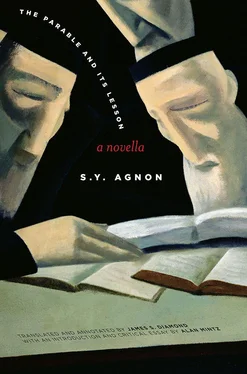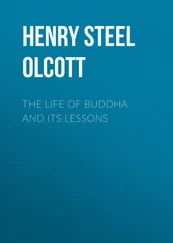A surprising digression at this juncture in the narrative makes an important connection between two of the story’s preoccupations. The shamash is struggling to resolve the troubling contradiction between a seemingly minor offense and its terrible punishment, when he suddenly halts his story and surveys his listeners, among whom, he realizes, are scholars as well as community leaders who are not scholars. He turns to them and says:
Now listen to me all you people of Buczacz. You think that Gehinnom is only for Torah scholars. Well, let me tell you otherwise. There is one area there compared to which all the rest of Gehinnom is like Gan Eden. I never noticed it at first because it was covered in dust. But the voices that could be heard through the dust suggested that there were people there. I could not tell if they were people or cattle or fowl until I went in and saw that it was one huge market fair, like the ones our great-grandparents and those who came before them used to tell about, before Khmelnitski, may his name be blotted out. There were traders, dealers, noblemen and noblewomen, goods galore — like you’ve never seen before. Silver and gold and all kinds of expensive things. Then suddenly the whole fair was thrown into a panic. The Tatars had arrived. They came on swift horses in rumbling hordes. My body trembles even now as I recall it. I will stop talking about it and go back to where I left off. (35)
The shamash’s outburst is all the more intriguing for its strangeness and disconnection from what comes before and after it. Although he labels the scene of the fair and the horsemen as yet another compartment ( mador ) of Gehinnom, it quickly becomes recognizable as connected to the Tatar incursions of the 1670s rather than to the afterlife. It is different from anything that has come before because the suffering it represents is unrelated to any misdeeds that might have provoked it, and the ordeal is collective in nature rather than pertaining to the culpability of the individual soul. The scene belongs, in short, to an entirely different kind of discourse: the historical tribulations of Israel in recent persecutions. Even within this category, there is much that remains strange. Rather than picturing recent events, the tableau evokes an imagined earlier era of great commercial wealth and weighty transactions between Polish rulers and Jewish traders at the great market fairs. It is this older world that is made the target of the swift and devastating incursions of the Tatar horsemen, scourges that in fact come from a later period, the 1670s. The conflation of time and the sketchy, fragmentary evocation of events lend this scene the quality of a nightmare. It can be understood as a posttraumatic memory in light of all we have gleaned from the pervasive persistence of 1648 in our story. “My body trembles even now as I recall it,” confesses the shamash.
The digression breaks off as abruptly as it began. Yet by the time the shamash regains his composure and determines to “go back to where I left off,” he has unwittingly broached the link between the two kinds of trauma in the story, both hitherto presented as unrelated to one another. On the one hand, there are the events of 1648 and their pervasive baleful consequences for all the Jews of Buczacz, including the shamash’s wife, who witnessed the murder of her parents and seven siblings (43), and the shamash himself, whose family was also wiped out. The orphaning of Zlateh and the apostasy of Aaron also belong to this line of the narrative. On the other hand, there are the horrific tortures suffered by prideful and self-important scholars in Gehinnom forming the main story the shamash has been relating. Although a connection between them is made neither by the narrator nor by the shamash, they are both alive and comingled in the unconscious imagination of the shamash, as evinced by the digression about the Tatar horsemen and its surprising placement within the tour of Gehinnom. There is of course an implicit connection between the two, but it is one that is not thinkable to the figures in the story — except perhaps Aaron. It is only we, the modern readers, who, through Agnon’s agency, can see it clearly. It is the shared theological problem of incommensurability. How is it possible that the sins of Ukrainian Jewry were so unspeakable as to have warranted the horrors of Khmelnitski and his hordes? How is it possible that infractions of well-meaning scholars can result in unspeakable tortures for eternity? In both cases, the physical afflictions are horrible enough in their own right, but the enduring suffering, when it comes to the surviving and living, comes from the festering cognitive-theological wound that has been opened up.
The coexistence and even commingling of 1648 and Gehinnom in the shamash’s mind beg further questions: Is one the result of the other? Is the preoccupation with matters beyond the grave an outcome of a consciousness rooted in mass death and sacrifice? Is it the pervasiveness of death, arising from persecutions that took place in a concrete political-historical context, that generates the anxiety about postmortem punishments and their stringencies? The answer to these questions, as well as to the question of incommensurability, are located beyond the theological imagination of both the narrator and the shamash; the farthest they can go is to mark the wall that has been reached with the modest understatement, qetsat qasheh (It is a little difficult). 22The notion that 1648 may be the generating cause is expressed in the shamash’s repeated insistence that the tale of Aaron’s apostasy and his discovery in Gehinnom is merely preparatory and subservient to the main moral teaching about inappropriate speech. It is ultimately in the narrative syntax of the story that Agnon wrestles with these questions. The shamash returns from his tour of Hell between Yom Kippur and Sukkot, with many questions about the plausibility of what he has witnessed buzzing in his head; but within half a chapter it is suddenly late spring, and the monumental description of the twentieth of Sivan memorial takes over the story. Immersion in the 1648 theme kidnaps the story for the length of these protracted ceremonies, until the point at which the Rabbi at the very end arrives at his parable, which he uses to refocus the narrative and once again underscore the gravity of inappropriate speech. The story as a whole, in sum, stages a contest in which the spiritually wasting forces of death unleashed by 1648 are resisted by the desire to impose a moralizing meaning on the experience of life and death.
Stepping back and looking at the Gehinnom episode as a whole, we see clearly its extraordinary nature. On his return, the shamash himself can barely believe it has taken place because it is so disturbingly at odds with what he knows about the afterlife. Having been plucked from time and space and exposed to confounding horrors, he has difficulty in accommodating to the fact that life in Buczacz proceeds as usual. Perplexingly, the rabbi takes no action on Zlateh’s case as a result of having confirmed the fact of Aaron’s death. Her situation, in fact, is resolved only when a mysterious emissary from the East comes to Buczacz bearing a writ of divorce, which could only have been written when Aaron was alive. Yet despite these peculiarities, the shamash insists on the truth of his experience: “The three compartments of Gehinnom that I have noted I saw while completely awake and not in a dream. The same goes for the judgments visited upon all who talk during the prayers and the Torah reading” (39). And whatever hesitations the shamash himself may have had, the people of Buczacz are entirely persuaded by his testimony. So much so that they treat him like a revered authority, surrounding him and pestering him with endless trivial questions about the precise conditions that obtain in Gehinnom (Chapter 25).
Читать дальше












![Edward Ellis - Adrift on the Pacific - A Boys [sic] Story of the Sea and its Perils](/books/753342/edward-ellis-adrift-on-the-pacific-a-boys-sic-s-thumb.webp)